Seven of the nation’s administrative regions, encompassing 57.2 percent of Taiwan’s townships and villages, became “super-aged societies” in June, the Ministry of the Interior said in its latest report.
A region is considered super-aged if 20 percent of the population is aged 65 or older.
The ministry report showed that Taiwan had 4,391,744 people aged 65 or older as of June, representing 18.76 percent of the total population and an increase of 1,024,425 people compared with August 2018.

In June, the nation’s elderly dependency ratio was 27.3 senior citizens per 100 working-aged people, an increase of 7.39 people over August 2018, it said.
That means there were about four working-aged Taiwanese for every person aged 65 or older who needed support, down from five last year, it said.
Chiayi County was the oldest region with 22.77 percent of its population aged 65 or older, followed by Taipei at 22.51 percent, Nantou County at 21.28 percent, Yunlin County at 20.85 percent, Keelung at 20.76 percent, Pingtung County at 20.54 percent and Hualien County at 20.2 percent, the report said.
Taipei and Keelung likely made the list due to the draw of better access to medical resources in the cities, the ministry said.
Hsinchu County, Hsinchu City, Lienchiang County and Taoyuan were the youngest regions with people older than 65 accounting for 14.25 percent, 15.06 percent, 15.4 percent and 15.48 percent of the local population respectively, it said.
The prevalence of young people in the jurisdictions — especially in Hsinchu county and city, home of the nation’s semiconductor industry — were likely linked to the high availability of jobs or other geographical factors, the ministry said.
Taiwan People’s Party Legislator Wu Chun-cheng (吳春城) last week introduced a bill urging the government to adjust its economic policy to account for the country’s aging population.
The bill, cosigned by legislators from across party lines, calls for replacing official language referring to “old age” and “senior citizens” with terms such as “the long-lived” and “of the strong generation.”
Taiwan is expected to lose 10 million people from its population in the next five decades to become the fastest-aging society in the world, Wu wrote in the bill’s statement of purpose, citing National Development Council data.
The nation must establish a basic law to address the aging crisis, as Japan did 30 years ago, he said, adding that Taiwan cannot afford inaction.
A Democratic Progressive Party lawmaker, speaking on the condition of anonymity, said that the bill’s proponents should provide a clearer definition for terms such as “the strong generation” before passing amendments.

TRAGEDY STRIKES TAIPEI: The suspect died after falling off a building after he threw smoke grenades into Taipei Main Station and went on a killing spree in Zhongshan A 27-year-old suspect allegedly threw smoke grenades in Taipei Main Station and then proceeded to Zhongshan MRT Station in a random killing spree that resulted in the death of the suspect and two other civilians, and seven injured, including one in critical condition, as of press time last night. The suspect, identified as a man surnamed Chang Wen (張文), allegedly began the attack at Taipei Main Station, the Taipei Fire Department said, adding that it received a report at 5:24pm that smoke grenades had been thrown in the station. One man in his 50s was rushed to hospital after a cardiac arrest

A car bomb killed a senior Russian general in southern Moscow yesterday morning, the latest high-profile army figure to be blown up in a blast that came just hours after Russian and Ukrainian delegates held separate talks in Miami on a plan to end the war. Kyiv has not commented on the incident, but Russian investigators said they were probing whether the blast was “linked” to “Ukrainian special forces.” The attack was similar to other assassinations of generals and pro-war figures that have either been claimed, or are widely believed to have been orchestrated, by Ukraine. Russian Lieutenant General Fanil Sarvarov, 56, head

SAFETY FIRST: Double the number of police were deployed at the Taipei Marathon, while other cities released plans to bolster public event safety Authorities across Taiwan have stepped up security measures ahead of Christmas and New Year events, following a knife and smoke bomb attack in Taipei on Friday that left four people dead and 11 injured. In a bid to prevent potential copycat incidents, police deployments have been expanded for large gatherings, transport hubs, and other crowded public spaces, according to official statements from police and city authorities. Taipei Mayor Chiang Wan-an (蔣萬安) said the city has “comprehensively raised security readiness” in crowded areas, increased police deployments with armed officers, and intensified patrols during weekends and nighttime hours. For large-scale events, security checkpoints and explosives

PUBLIC SAFETY: The premier said that security would be tightened in transport hubs, while President Lai commended the public for their bravery The government is to deploy more police, including rapid response units, in crowded public areas to ensure a swift response to any threats, President William Lai (賴清德) said yesterday after a knife attack killed three people and injured 11 in Taipei the previous day. Lai made the remarks following a briefing by the National Police Agency on the progress of the investigation, saying that the attack underscored the importance of cooperation in public security between the central and local governments. The attack unfolded in the early evening on Friday around Taipei Main Station’s M7 exit and later near the Taipei MRT’s Zhongshan